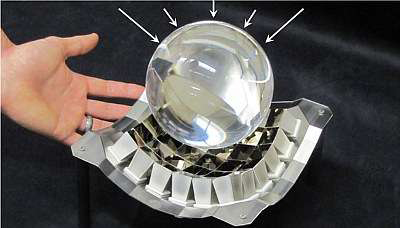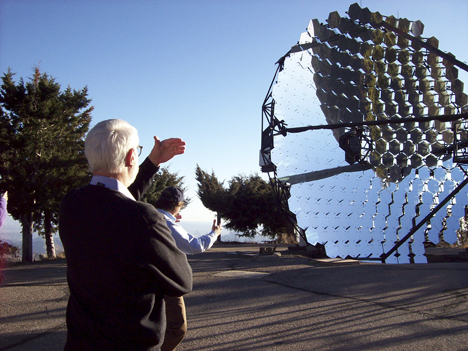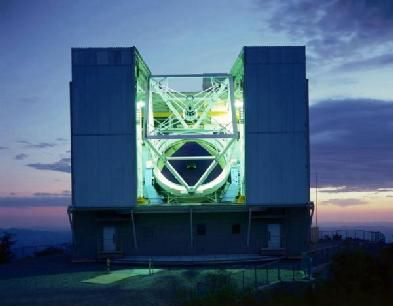On the road in Arizona: Part 2
(Click here to read part one of the Secretary’s Arizona travel journal.)
March 9, 2011. Tucson—clear, cool with abundant sunshine. Morning temperature, 50 degrees.
Astronomers love Tucson and Tucson loves astronomers. The city is ringed by craggy mountain peaks topped by observatories, including Kitts Peak, Mt. Hopkins, and Mt. Graham. Astronomers seek out these sites for their high elevations, clear skies and low humidity. Tucson returns the favor by being one of the few cities in the world with an ordinance that calls for limiting the light that is emitted into the night sky—light that would make astronomical viewing more difficult and limit the usefulness of the observatories.
The Mirror Laboratory

Artist’s concept showing the seven 8.4-meter mirrors of the Giant Magellan Telescope Observatory.. (credit: GMTO)
At the heart of this unique world of astronomy is the University of Arizona, and it is no surprise that it is deeply involved in the field. Not only is astronomy part of the university’s academic offerings, but also the university is home to the world-famous Mirror Laboratory, part of the Steward Observatory, and our first stop of the day. The Mirror Lab is in the process of making the first of seven 8.4-meter- diameter mirrors for the Giant Magellan Telescope. When completed, the GMT will be able to see objects in space 10 times more clearly than the famed Hubble Space Telescope. The GMT will be located at the Las Campanas Observatory in Chile, and is a collaborative venture led by the Carnegie Institution for Science; several universities, including The University of Arizona; two countries, Korea and Australia; and the Smithsonian.
The hosts for our visit include Peter Strittmatter, head of the astronomy department at UA and the director of the Steward Observatory, and Roger Angel, the director of the Mirror Lab and the creative genius behind its revolutionary capability to build huge, single-piece mirrors. You might expect that the Mirror Lab would operate undisturbed in some isolated area, but it hums along, cozied up under the Arizona Wildcats football stadium in one of the busiest parts of campus. The Lab continues its work during the football games, although Roger does admit it is not easy to find parking for the staff on game day.
Roger and Peter begin the tour by helping us understand the history of the Mirror Lab and the Steward Observatory. One of the seminal projects that launched the Lab was the Multiple Mirror Telescope—the joint effort of the Steward Observatory and the Smithsonian Astrophysical Observatory to build a large telescope observatory on the peak of Mt. Hopkins. Conceived in the early 1970s, the MMT, with six 1.8-meter diameter mirrors was a concept that advanced the state of the art. Later in the 1990s, the MMT was transformed using Mirror Lab technology to a single large 6.5-meter mirror, another pioneering step forward. This mirror was cast with a large number of voids in the base so that the weight of the glass needed for the mirror was minimized making it much easier to maintain the parabolic shape needed. Over time, the techniques for making these mirrors has been further refined so that even larger mirrors can be created.

Pieces of E6 low-expansion borosilicate glass are made by the Ohara Corp. in Japan with sand from the beaches of Florida.e the glass comes from the beaches of Florida.
The process of casting the large mirrors involves melting borosilicate glass blocks in a large form that rotates so that the desired shape of the mirror is created naturally due to centrifugal force. Next, the surface is refined using mechanical robots to buff and polish any imperfections in the mirror. This exacting process is described in detail on the Mirror Lab’s website.
A highlight for us is being able to see close-up the first 8.4-meter mirror created for the GMT being polished. The visual image is striking. This inert glass giant will someday collect light from galaxies that lie 13 to 14 billion light years from our small planet, distances that define the limit of our known universe. Unseeing and unknowing, it will allow the species Homo sapiens for the first time to plumb the depths of how the universe formed. What will this knowledge mean and what use will we make of it? I hope it leads to a greater understanding of who we are as a people and the respect we should have for the blue orb of life given to us.
The last part of our tour gives Roger a chance to inform us about his newest venture: using mirror technology to focus the energy of the sun to create a reliable energy source. Much work has been done on photovoltaic cell technology and its potential is steadily improving, but it is not yet cost- competitive with carbon fuels, and is inefficient in low levels of sunlight. Roger’s new idea is to use mirror technology to focus the sun’s rays toward solar cells so that they can more productively generate energy. The mirror approach is appealing in that it uses readily available mass-produced glass panels that can be mounted in inexpensive steel structures designed to harvest the sun’s energy. It also offers an advantage in that all of the parts and the structure are made here in the United States and will be assembled locally, helping create jobs. The concept is exciting and encouraging. Pilot projects are underway and I say, ‘Godspeed!’ This could be a win-win-win, helping solve our energy problems, reducing use of carbon-based fuels and creating jobs here at home.

Sunlight from the reflector dish comes to a highly concentrated focus near the center of the ball lens and an array of optical funnels captures and further concentrates the light. Image courtesy of REhnu LLC.
The Fred Lawrence Whipple Observatory
We depart from the University of Arizona and head south toward the Santa Rita Mountains. The temperature has reached a pleasant upper 70s in Tuscon. Forty-five minutes later, some 30 miles north of the U.S./Mexican border, we turn left off the highway and head east toward the looming presence of Mt. Hopkins. Our road winds as it climbs toward the “base camp” for the Whipple Observatory. Base camp consists of an attractive visitors’ center, a logistics base for the observatories that lie above on the mountain, and the sophisticated VERITAS high-energy telescope array. We are greeted by Dan Brocious, the public affairs officer for the Observatory with responsibility for visitors, media and education programs.
The visitors’ center not only helps the steady stream of visitors learn about the work of the Whipple Observatory, but also provides an array of opportunities for them to tackle enjoyable learning exercises. Visitors can become amateur astronomers by operating two small telescopes located just outside the center using a desktop computer. These telescopes can be operated remotely by anyone using the Internet with access obtained through the SAO website and are proving to be a boon to teachers and learners alike. The center has an exhibition on the local flora and fauna that helps visitors appreciate the desert ecosystem as they drive or hike on the mountain.
Visually dominating the base camp site are the four 12- meter diameter telescopes of the Very Energetic Radiation Imaging Telescope Array System, or VERITAS. Each telescope is composed of nearly 200 mirror segments (I counted) giving the face the appearance of a large waffle iron. They are designed to collect information to understand the sources of galactic cosmic rays and what they tell us about fundamental equations such as how galaxies and stars are formed. VERITAS is one of only a few such systems in the world and is the most sensitive.
Our tour of the telescopes demonstrates the system’s sophistication, with the recording occurring automatically using high-end sensors and computing technology. One of the tricks of the trade is in resurfacing the hundreds of mirrors in the telescopes to keep the viewing efficiency high. This is accomplished using an innovative facility that allows all of the mirrors to be completely resurfaced over a three-year period. In the few short years it has been in operation, VERITAS is already generating new insights into how our universe works.
One of the highlights of my visit to the base camp is the opportunity to bring the staff of the Whipple Observatory up-to-date on Smithsonian activities and to have time for questions and answers. The session is very productive and good questions are asked about our budget and new science projects, the latter allowing Charles to bring the staff up to date on SAO activities.
After a reception with the staff, we depart base camp in a convoy headed up the mountain. The Forest Service maintains the road until it reaches the upper observatory site, where it becomes a Smithsonian responsibility. With an elevation change of about 1,500 meters (4,500 feet) over a short distance, drivers have to pay close attention to the frequent curves while avoiding the edges of the road that fall off to canyons far below. Just in case we have not taken the hazards posed by the road seriously, Charles insists that we stop along the way at a spot where a Smithsonian researcher lost control of a vehicle not long ago and rolled down the canyon walls. Fortunately, he was not seriously injured but the accident led to a new barrier being placed at this curve. For our part, we do pay more attention to how close the cars get to edge of the narrow road.
Along the way, Dan treats us to a running commentary about the flora, which changes dramatically as we increase elevation. At higher elevations, the amount of precipitation increases and the temperature drops significantly, creating a different ecosystem from that of the lower elevations. Leaving base camp, we see a variety of cacti, including the common green prickly pear, the rose-purple-hued Santa Rita prickly pear and the chollo with its branching tree-like shape. Mesquite and live oak are the dominant tree species in the lower elevations. About halfway up to the summit, the forests become green and are populated by pines, including the Ponderosa, the Arizona and the beautiful long- leaf Apache. Snow patches in the shady areas let us know the temperatures have dropped considerably from the warmth of the valley floor. The snow is important as a water source not only for the plants and animals, but for the Observatory itself.
We arrive safely near the peak of Mt. Hopkins after a 20-minute ride and enjoy a stunning view of the valley below. On leaving the vehicles, we feel the need for a few more clothing layers as the temperature is in the 30s with a crisp wind blowing. Astronomer Emilio Falco-Acosta walks us through a tour of the facilities, which includes a series of small telescopes that serve the Observatory site—ranging from 1.5-meter reflectors to a 10-meter gamma ray unit that was a predecessor to the VERITAS array. Two arrays of small reflector telescopes are housed nearby that are operated robotically and are used in the search for exoplanets.
With the sun beginning to set, we make a quick run up to the peak of Mt. Hopkins for our first look at the MMT. Perched on top of a small level rock outcropping, with little room to spare, the facility consists of a support building and the four-story MMT building itself. MMT Associate Director Grant Williams and several of his staff take us on our initial tour of the facility. The MMT building consists of a control room underneath a large high bay area that holds the massive steel frame for the 6.5-meter mirror. The frame uses an “altitude-azimuth” mount that allows both horizontal and vertical axes to be used in tracking the telescope. When the telescope is observing the sky, the roof and walls of the high bay are opened to the sky.
All of this is impressive, but another surprise awaits as the upper part of the building housing the telescope begins to rotate, which allows the telescope full access to the building aperture at all times. The engineer in me marvels as I watch the two million-pound building turn freely on a base that rides on four large wheels. This remarkable design feat was the brainchild of J.T. Williams, an Observatory engineer who is now nearing retirement.
We are encouraged to step outside the building to watch the sun set behind the western mountain range across the valley floor. A nearby forest fire has deepened the reds of the sunset as drifting smoke is held low by an inversion layer. As the sun drops to the horizon J.T. tells us that if we are lucky, we may see a green flash just as the sun disappears behind the mountains. Sure enough, several of those watching, including J.T., claim to have seen not one green flash, but two. I have heard about the “green flash” on the east coast where it supposedly can be seen as the sun sets across the flat profile of low lying marsh grass or ocean. Perhaps my eyes are just not configured to see the green flash because I have never seen it over the marshes nor did I see it here. Charles joins me in not being sure if this is a trick the locals play on unsuspecting rubes, but J.T. and others are sure they saw the flash and have an explanation for it. And indeed, even Wikipedia seems to have a full explanation in terms of the physics and chemistry, including several convincing photographs. I will just have to concentrate harder it seems if I am to join the club of observers in the future.

(We considered Photoshopping a green flash for the Secretary, but decided against it –Ed.) Photo by Amanda Preston
With darkness arriving, it is time for us to head down from the peak to our dorms and the dining hall for dinner. We are assigned rooms in the dorms with prominent signs along the walls noting that astronomers sleep in the day and deserve quiet. Amanda Preston and the staff of the Observatory have worked with a local caterer to serve up a delightful dinner that appeals to appetites sharpened by a long day’s activities.
Following our repast, we head up the mountain again to the MMT so we can watch the work ongoing this evening. The headlights on our vehicles are turned off as we approach the MMT so as not to damage any exposures being made. Inside the control room two Chinese scholars who are visiting the University of Arizona are focused on making observations of faint galaxies barely visible even to the MMT telescope. Fortunately, the conditions for viewing tonight are ideal and they are able to make images of a galaxy that is located 12 billion light years from earth. The excitement of the scientists is infectious.
We conclude our evening with a visit to the support equipment bay where some of the remarkable tools that are used in the observing process are explained. This includes a device called “Fred and Ginger,” designed by the SAO’s Daniel Fabricant, which uses robotic techniques to line up tiny probes at the precise point needed to guide the telescope to the right location for observations. The reference to the famous dancers, Fred Astaire and Ginger Rogers, is apt as the robots move in sinuous patterns around the plate to place the probes.
Back in the dorm, my bed feels good after a long day. I feel very fortunate to have been able to meet the outstanding people of the Whipple Observatory and the University of Arizona Steward Observatory and to have been exposed to some of the wonders of the world of astronomy.
We rise early and watch as the sun’s rays warm the tops of lower peaks and the valleys below. Somewhat reluctantly, we begin our descent to base camp where we load our gear into the vehicle that will transport us back to Tucson and our flights home.
Posted: 28 March 2011
-
Categories:
Astrophysical Observatory , Feature Stories , From the Secretary , Science and Nature














